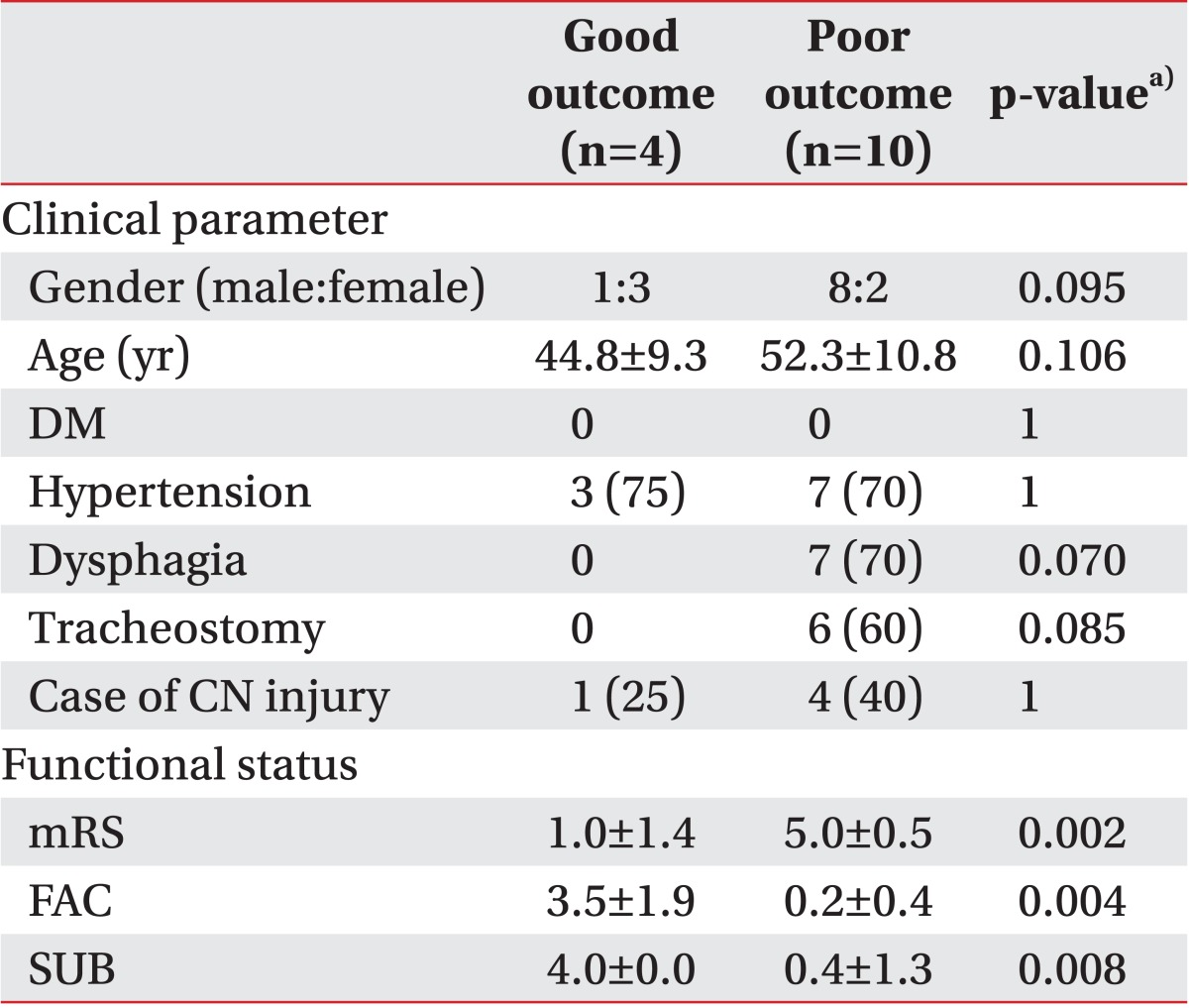1. Wessels T, Moller-Hartmann W, Noth J, Klotzsch C. CT findings and clinical features as markers for patient outcome in primary pontine hemorrhage. AJNR Am J Neuroradiol. 2004; 25:257–260. PMID:
14970027.
2. Wijdicks EF, St Louis E. Clinical profiles predictive of outcome in pontine hemorrhage. Neurology. 1997; 49:1342–1346. PMID:
9371919.

3. Murata Y, Yamaguchi S, Kajikawa H, Yamamura K, Sumioka S, Nakamura S. Relationship between the clinical manifestations, computed tomographic findings and the outcome in 80 patients with primary pontine hemorrhage. J Neurol Sci. 1999; 167:107–111. PMID:
10521548.

4. Jung DS, Jeon BC, Park YS, Oh HS, Chun TS, Kim NK. The predictors of survival and functional outcome in patients with pontine hemorrhage. J Korean Neurosurg Soc. 2007; 41:82–87.
5. Jang JH, Song YG, Kim YZ. Predictors of 30-day mortality and 90-day functional recovery after primary pontine hemorrhage. J Korean Med Sci. 2011; 26:100–107. PMID:
21218037.

6. Masiyama S, Niizuma H, Suzuki J. Pontine haemorrhage: a clinical analysis of 26 cases. J Neurol Neurosurg Psychiatry. 1985; 48:658–662. PMID:
4031910.

7. Lee SY, Lim JY, Kang EK, Han MK, Bae HJ, Paik NJ. Prediction of good functional recovery after stroke based on combined motor and somatosensory evoked potential findings. J Rehabil Med. 2010; 42:16–20. PMID:
20111839.

8. Banks JL, Marotta CA. Outcomes validity and reliability of the modified Rankin scale: implications for stroke clinical trials: a literature review and synthesis. Stroke. 2007; 38:1091–1096. PMID:
17272767.
9. Oh HM, Im S, Ko YA, Ko SB, Park GY. The sitting-unsupported balance score as an early predictor of functional prognosis in stroke patients: a pilot study. Ann Rehabil Med. 2013; 37:241–246. PMID:
23705120.

10. Mehrholz J, Wagner K, Rutte K, Meissner D, Pohl M. Predictive validity and responsiveness of the functional ambulation category in hemiparetic patients after stroke. Arch Phys Med Rehabil. 2007; 88:1314–1319. PMID:
17908575.

11. Broderick JP, Brott TG, Duldner JE, Tomsick T, Huster G. Volume of intracerebral hemorrhage: a powerful and easy-to-use predictor of 30-day mortality. Stroke. 1993; 24:987–993. PMID:
8322400.

12. Chung CS, Park CH. Primary pontine hemorrhage: a new CT classification. Neurology. 1992; 42:830–834. PMID:
1565238.

13. Rossini PM, Narici L, Martino G, Pasquarelli A, Peresson M, Pizzella V, et al. Analysis of interhemispheric asymmetries of somatosensory evoked magnetic fields to right and left median nerve stimulation. Electroencephalogr Clin Neurophysiol. 1994; 91:476–482. PMID:
7529686.

14. Jang SH, Ahn SH, Sakong J, Byun WM, Choi BY, Chang CH, et al. Comparison of TMS and DTT for predicting motor outcome in intracerebral hemorrhage. J Neurol Sci. 2010; 290:107–111. PMID:
19914639.

15. Lancman M, Norscini J, Mesropian H, Bardeci C, Bauso T, Granillo R. Tegmental pontine hemorrhages: clinical features and prognostic factors. Can J Neurol Sci. 1992; 19:236–238. PMID:
1623452.

16. Dziewas R, Kremer M, Ludemann P, Nabavi DG, Drager B, Ringelstein B. The prognostic impact of clinical and CT parameters in patients with pontine hemorrhage. Cerebrovasc Dis. 2003; 16:224–229. PMID:
12865609.

17. Balci K, Asil T, Kerimoglu M, Celik Y, Utku U. Clinical and neuroradiological predictors of mortality in patients with primary pontine hemorrhage. Clin Neurol Neurosurg. 2005; 108:36–39. PMID:
16311143.

18. Patel AT, Duncan PW, Lai SM, Studenski S. The relation between impairments and functional outcomes poststroke. Arch Phys Med Rehabil. 2000; 81:1357–1363. PMID:
11030501.

19. Carey LM, Matyas TA. Frequency of discriminative sensory loss in the hand after stroke in a rehabilitation setting. J Rehabil Med. 2011; 43:257–263. PMID:
21305243.

20. Davidoff RA. The pyramidal tract. Neurology. 1990; 40:332–339. PMID:
2405296.

21. Johansson RS, Cole KJ. Sensory-motor coordination during grasping and manipulative actions. Curr Opin Neurobiol. 1992; 2:815–823. PMID:
1477545.

22. Ferbert A, Buchner H, Bruckmann H. Brainstem auditory evoked potentials and somatosensory evoked potentials in pontine haemorrhage: correlations with clinical and CT findings. Brain. 1990; 113(Pt 1):49–63. PMID:
2302537.







 PDF
PDF ePub
ePub Citation
Citation Print
Print


 XML Download
XML Download